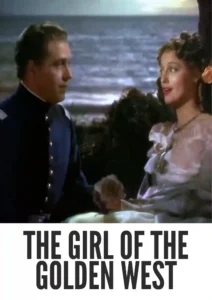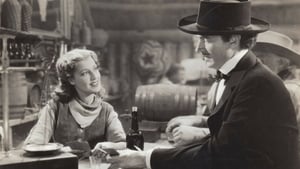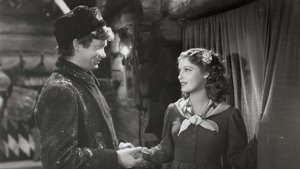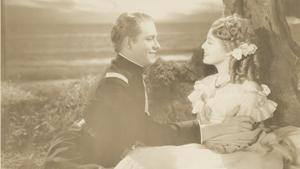Contact: info@alwanfilm.com
Video Sources 0 Views
- The Girl of the Golden West 1938 Colorized


Synopsis
Table of Contents
ToggleThe Girl of the Golden West 1938 Colorized Review: A Melodramatic Western Classic

Introduction
The Girl of the Golden West (1938) stands as a hallmark of 1930s American cinema, blending the Western genre with elements of melodrama and music. Directed by the illustrious George Stevens, this film adaptation of David Belasco’s 1905 play captures the spirit of the Wild West while offering a poignant narrative about love, sacrifice, and the pursuit of happiness. Released during a time when the Western genre was gaining popularity, this film incorporates a rich tapestry of emotions and character development. In this review, we will explore the significance of The Girl of the Golden West (1938), examining how its themes and performances resonate within the context of cinematic history, while also reflecting on the film’s enduring legacy.
Check The Full Colorized Movies List
Check Our Colorized Movies Trailer Channel
Understanding The Girl of the Golden West 1938 Colorized: Director, Cast, and Genre
Director’s Vision
George Stevens, an acclaimed director known for his storytelling prowess, brought a unique vision to The Girl of the Golden West (1938). His ability to capture both the grandeur of the Western landscape and the emotional depth of his characters is evident throughout the film. Stevens combined the theatricality of Belasco’s original play with his cinematic techniques, creating a rich and immersive experience for the audience.
The film features a blend of sweeping landscapes, intimate character moments, and dramatic tension, all hallmarks of Stevens’ directorial style. His use of close-ups and sweeping camera movements captures the emotional intensity of the narrative, inviting the audience into the world of the Gold Rush.
The Iconic Performance of Actors
At the heart of The Girl of the Golden West is the powerful performance of the legendary Jeanette MacDonald, who portrays the fiery and resilient character of Minnie. MacDonald, known for her operatic singing voice and charismatic presence, brings a captivating energy to the role. Her ability to convey a wide range of emotions—from strength and determination to vulnerability and love—makes her portrayal of Minnie unforgettable.
Opposite MacDonald is Nelson Eddy, who plays the dashing bandit, Dick Johnson. Eddy’s performance balances charm and danger, embodying the complexities of his character. Their on-screen chemistry is palpable, adding depth to the romantic storyline and elevating the film’s emotional stakes.
Exploring the Genre
The Girl of the Golden West (1938) occupies a unique space within the Western genre. While it adheres to many conventions of the genre—such as the setting in the American West, themes of lawlessness, and the classic battle between good and evil—it also incorporates elements of musical theatre and melodrama. This blending of genres allows for a rich exploration of character and emotion, setting it apart from traditional Westerns of the era.
The film’s focus on romance and personal relationships contrasts with the more action-driven narratives typical of many Westerns. Instead of centering on gunfights and rugged cowboys, The Girl of the Golden West prioritizes the emotional journeys of its characters, making it a distinctive entry in the genre.
Exploring the World of The Girl of the Golden West 1938 Colorized: Plot and Characters
Detailed Synopsis
Set against the backdrop of the California Gold Rush, The Girl of the Golden West (1938) follows the story of Minnie, a strong-willed saloon owner played by Jeanette MacDonald. Minnie’s bar, the “Polka,” serves as a gathering place for miners and outlaws alike, and she is known for her fierce independence and loyalty to her patrons.
The plot thickens when Minnie falls in love with the mysterious Dick Johnson, played by Nelson Eddy. Unbeknownst to her, Dick is actually the infamous outlaw wanted by the law. As their romance develops, Minnie is torn between her feelings for Dick and her duty to protect her town from his criminal activities.
The film reaches a climax when a group of vigilantes comes to the Polka, seeking to capture Dick. In a moment of bravery and sacrifice, Minnie stands up for her love, leading to dramatic confrontations and heartfelt decisions. The story ultimately explores themes of love, honor, and the lengths one will go to protect those they care for.
The Complex Protagonist and Memorable Supporting Characters
Minnie is a complex protagonist, embodying both strength and vulnerability. Her character is a reflection of the challenges faced by women during the Gold Rush, as she navigates a world dominated by men while asserting her independence. MacDonald’s portrayal of Minnie captures her spirit and determination, making her a relatable and inspiring character.
The supporting cast also features memorable characters, including the grizzled sheriff and the miners, who contribute to the film’s overall narrative. Each character adds depth to the story, enriching the themes of loyalty, community, and sacrifice that permeate the film.
The Art of Cinematic Adaptation
Adapting Belasco’s Play
The transition from stage to screen is often fraught with challenges, yet The Girl of the Golden West (1938) successfully adapts David Belasco’s original play into a cinematic experience. The film retains the emotional core of the play while expanding on the visual elements that cinema allows.
Stevens utilizes the vast landscapes of the American West to enhance the narrative, employing wide shots that showcase the natural beauty and danger of the frontier. The cinematography captures the stark contrasts between the rugged outdoors and the warmth of Minnie’s saloon, symbolizing the dichotomy of love and lawlessness that defines the story.
The musical numbers, integral to MacDonald and Eddy’s performances, also add a layer of depth to the adaptation. The songs serve not only as entertainment but as emotional expressions that deepen the connection between the characters and the audience.
Early Musical Films: A Brief History
The Rise of Musical Films
The late 1930s saw the rise of musical films as a popular genre in Hollywood, with studios recognizing the potential for music to enhance storytelling. Musical numbers provided an escape for audiences during a tumultuous period in history, offering joy and a sense of wonder.
The Girl of the Golden West (1938) exemplifies this trend by blending Western themes with musical elements, appealing to a wide range of viewers. The success of such films encouraged more studios to explore the combination of genres, leading to innovative storytelling techniques that would shape the future of American cinema.
The Girl of the Golden West 1938 Colorized and Its Musical Legacy
The Decision to Integrate Music
The incorporation of music into The Girl of the Golden West (1938) was a deliberate choice that served to enhance the film’s emotional landscape. The film features several memorable songs performed by MacDonald and Eddy, which not only showcase their vocal talents but also advance the narrative.
The musical numbers provide insight into the characters’ emotions and motivations, allowing the audience to connect with them on a deeper level. Songs like “The Girl of the Golden West” and “Love Is Where You Find It” resonate with themes of longing and passion, encapsulating the essence of Minnie’s journey.
Impact on the Film’s Reception
The musical elements of The Girl of the Golden West contributed to its positive reception at the box office. Audiences were drawn to the film’s combination of romance, action, and music, making it a standout among contemporary releases. The success of this film helped solidify the place of musical Westerns in Hollywood, paving the way for future productions that would blend these genres.
The Debate Over Genre Mixing
Controversy Surrounding Genre Blending
While The Girl of the Golden West (1938) is celebrated for its innovative blending of genres, it has not been without its critics. Traditionalists argue that the inclusion of musical elements detracts from the authenticity of the Western genre, diluting the action and grit that define classic Westerns.
However, supporters of genre blending assert that it enriches storytelling by allowing for diverse emotional experiences. By combining the elements of musical theatre with Western themes, The Girl of the Golden West creates a unique cinematic experience that appeals to a broader audience.
Examining The Girl of the Golden West 1938 Colorized as a Melodramatic Western
Emotional Depth and Character Development
The melodramatic elements of The Girl of the Golden West (1938) add layers of emotional depth to the narrative. The film explores themes of love, sacrifice, and moral dilemmas, inviting viewers to reflect on the complexities of human relationships. Minnie’s internal struggles and her devotion to Dick Johnson resonate deeply, providing a compelling character arc.
Stevens’ direction ensures that the emotional moments are both poignant and impactful. The film’s ability to evoke empathy for its characters sets it apart from more straightforward Westerns, making it a rich exploration of the human experience.
Influence and Legacy: The Girl of the Golden West 1938 Colorized’s Impact on Cinema
The Musical Western Trend
The Girl of the Golden West (1938) significantly influenced the trend of musical Westerns that emerged in subsequent decades. Its success demonstrated that audiences were receptive to innovative storytelling that combined elements of different genres. This paved the way for films like Oklahoma! (1955) and Paint Your Wagon (1969), which continued the tradition of blending music and Western themes.
The film’s legacy is evident in its impact on the way stories are told in the genre, encouraging filmmakers to explore new narrative possibilities. The combination of music, romance, and action became a formula that many later productions would emulate.
Director’s Cinematic Legacy: Beyond The Girl of the Golden West 1938 Colorized
George Stevens’ Broader Influence
George Stevens’ directorial career extended beyond The Girl of the Golden West (1938), encompassing a variety of genres and themes. He is best known for his work on classics such as Giant (1956) and A Place in the Sun (1951), both of which showcased his versatility as a filmmaker.
Stevens’ ability to capture human emotions and his innovative storytelling techniques left a lasting impact on American cinema. His contributions to the Western genre, particularly through The Girl of the Golden West, continue to be studied and celebrated by filmmakers and scholars alike.
Themes Explored in The Girl of the Golden West 1938 Colorized
Love and Sacrifice
One of the central themes of The Girl of the Golden West (1938) is love and sacrifice. Minnie’s willingness to protect Dick, despite his criminal background, reflects the complexities of love in difficult circumstances. Her character embodies the notion that love often requires sacrifice and bravery.
The film explores how personal relationships are tested by external forces, such as societal expectations and moral dilemmas. Minnie’s struggle to reconcile her feelings for Dick with her loyalty to her community adds depth to the narrative, making it a poignant exploration of love’s complexities.
The Nature of Honor
Honor and integrity are also significant themes in The Girl of the Golden West (1938). Characters grapple with their sense of duty, as Minnie’s loyalty to Dick is challenged by the expectations of her community. The film raises questions about what it means to act honorably in a world filled with moral ambiguity.
Minnie’s decisions reflect her understanding of honor, as she navigates her love for Dick while striving to protect her town. The exploration of honor adds complexity to the film’s characters, enhancing their relatability and depth.
Reception and Controversy Surrounding The Girl of the Golden West 1938 Colorized
Initial Reviews and Audience Reactions
Upon its release, The Girl of the Golden West (1938) received positive reviews from critics, who praised its strong performances and emotional depth. Jeanette MacDonald and Nelson Eddy’s chemistry was highlighted, with many noting how their musical talents enhanced the film’s appeal.
However, some critics expressed concerns about the blending of genres, arguing that the musical elements detracted from the Western narrative. Despite these criticisms, the film found success at the box office and developed a devoted fan base.
Where to Watch The Girl of the Golden West 1938 Colorized Online
For those interested in experiencing The Girl of the Golden West (1938), the film is available on several streaming platforms, including Amazon Prime Video and Turner Classic Movies. DVD and Blu-ray versions, which include both the original film and special features, can also be found for purchase online.
FAQs About The Girl of the Golden West 1938 Colorized
Q: What is the significance of The Girl of the Golden West (1938)?
A: The Girl of the Golden West (1938) is significant for its innovative blend of the Western and musical genres, showcasing the emotional depth of its characters and the complexities of love and sacrifice.
Q: Who directed The Girl of the Golden West (1938)?
A: The film was directed by George Stevens, a renowned filmmaker known for his ability to capture human emotions and innovative storytelling.
Q: What themes are explored in The Girl of the Golden West (1938)?
A: The film explores themes of love, sacrifice, honor, and the complexities of human relationships set against the backdrop of the Gold Rush.
Q: How has The Girl of the Golden West (1938) influenced later films?
A: The film has influenced the trend of musical Westerns, encouraging filmmakers to explore new narrative possibilities by combining different genres.
Conclusion
The Girl of the Golden West (1938) remains a captivating film that skillfully blends the Western genre with elements of melodrama and music. George Stevens’ direction, combined with the powerful performances of Jeanette MacDonald and Nelson Eddy, creates a memorable cinematic experience that resonates with audiences even today. The film’s exploration of love, sacrifice, and honor contributes to its lasting legacy within American cinema. As viewers continue to discover or revisit this classic, The Girl of the Golden West serves as a reminder of the richness and complexity that can be found in the intersection of genres, leaving a mark on the film industry that endures to this day.


















